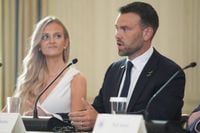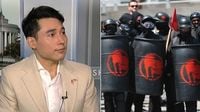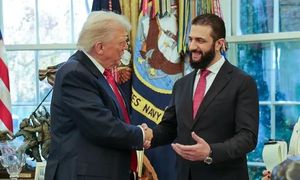In a week marked by escalating rhetoric and stark divisions, the Department of Homeland Security (DHS) released evidence that has reignited the national debate over Antifa and the threat of domestic terrorism. On October 10, 2025, DHS shared a chilling voicemail in which the family of a U.S. Immigration and Customs Enforcement (ICE) officer in Texas was threatened with violence. According to DHS, the message—attributed to Antifa—warned, “Did you hear what happened to the Nazis after WWII, because that’s what’s gonna happen to your family.” The incident, publicized via DHS’s official X account, has become the latest flashpoint in a broader struggle over the nature of protest, law enforcement, and political violence in America.
“Antifa terrorists are threatening the FAMILIES of our law enforcement. We will hunt these sickos down and put them behind bars. In Texas, the spouse of an ICE officer received a voicemail filled with violent threats. If you don’t believe that radical anarchists want ICE law enforcement dead, listen to this,” the DHS posted. The message was unequivocal, drawing a line in the sand against what officials described as an organized campaign of intimidation targeting those who serve in law enforcement.
This development followed closely on the heels of a high-profile White House roundtable, convened by President Donald Trump on October 8, 2025. According to The Hill, the event brought together administration officials and several prominent right-wing commentators—among them Nick Sortor, recently arrested at a Portland ICE protest, conservative journalist Andy Ngo, commentator Jack Posobiec, and former reporter Brandi Kruse. The roundtable’s purpose was clear: to spotlight the administration’s aggressive efforts to confront Antifa, particularly as federal authorities attempted a military crackdown on protests in cities like Portland and Chicago.
During the roundtable, DHS Secretary Kristi Noem pulled no punches. “They are just as sophisticated as MS-13, as TdA, as ISIS, as Hezbollah, as Hamas, as all of them. They are just as dangerous. They have an agenda to destroy us, just like the other terrorists we’ve dealt with for many, many years,” Noem declared, as reported by BizPac Review. Her remarks reflected the administration’s view of Antifa not as a loose collection of activists, but as a highly organized and dangerous domestic threat.
The Trump administration’s stance on Antifa has hardened significantly in recent weeks. In September 2025, President Trump officially designated Antifa a terrorist organization, calling on all executive branch departments and agencies to “investigate, disrupt, and dismantle any and all illegal operations—especially those involving terrorist actions—conducted by Antifa or any person claiming to act on behalf of Antifa, or for which Antifa or any person claiming to act on behalf of Antifa provided material support, including necessary investigatory and prosecutorial actions against those who fund such operations.”
Attorney General Pam Bondi, also present at the roundtable, was equally emphatic: “This is not activism, it’s anarchy. We can’t and we will not let masked terrorists burn our buildings, attack our law enforcement and intimidate our communities,” she stated. The administration’s message was unmistakable—Antifa was to be treated with the same seriousness and resolve as any foreign terrorist threat.
Yet, as federal officials doubled down on their crackdown, a parallel narrative was unfolding in the media and among some political leaders. Critics of the administration’s approach, including prominent figures in entertainment and politics, accused the White House of exaggerating the threat posed by Antifa for political gain. On ABC, late-night host Jimmy Kimmel used his platform to lampoon the administration’s claims, saying, “There’s no Antifa. This is an entirely imaginary organization. There is not an Antifa. This is no different than if they announced they rounded up a dozen Decepticons. We’ve captured the chupacabra everyone.” Kimmel’s remarks, widely circulated on social media, were cited by BizPac Review as emblematic of what they described as a broader effort by “legacy media” to downplay or deny the existence of Antifa.
The divide was further illustrated by California Governor Gavin Newsom’s recent decision to sign a law banning face masks, a move intended to protect the identities of law enforcement officers amid ongoing tensions. While supporters hailed the measure as necessary for officer safety, critics argued it could stifle legitimate protest and further inflame confrontations between demonstrators and police.
Meanwhile, on the ground, violence and unrest continued to roil American cities. DHS Assistant Secretary Tricia McLaughlin, responding to Kimmel’s comments, pointed to grim statistics from Chicago: “There were 22 shootings and 4 murders in Chicago last weekend.” The numbers underscored the persistent volatility in urban centers and the challenges facing law enforcement, regardless of the political framing of the underlying causes.
The White House roundtable itself was notable not just for the officials in attendance, but for the inclusion of far-right commentators and activists who have made Antifa a central focus of their work. Nick Sortor, for instance, had recently been arrested at a Portland ICE protest after an alleged altercation with demonstrators, as reported by NBC News. Conservative journalist Andy Ngo and commentator Jack Posobiec are both known for their coverage of left-wing protests and have frequently highlighted confrontations involving Antifa.
For supporters of the administration, the roundtable and subsequent DHS actions represented a necessary and overdue response to what they see as a growing threat from radical anarchists. They argue that the violence and intimidation tactics attributed to Antifa are fundamentally incompatible with democratic norms and public safety. “We will hunt these sickos down and put them behind bars,” the DHS’s statement promised, echoing the tough-on-crime rhetoric that has defined much of the administration’s approach.
Opponents, however, see a different picture. They contend that the focus on Antifa serves as a political distraction from other pressing issues, and that the administration’s rhetoric risks conflating legitimate protest with terrorism. The presence of far-right commentators at a White House event, some argue, signals an attempt to further polarize the national conversation and delegitimize dissent. They point to statements like Kimmel’s and the skepticism voiced by figures such as Illinois Governor J.B. Pritzker, who has downplayed violence in Chicago, as evidence that the threat is being overstated for political effect.
Amid these competing narratives, one thing is clear: the debate over Antifa, protest, and political violence is far from settled. As federal authorities move forward with investigations and prosecutions, and as political leaders on both sides sharpen their rhetoric, the issue is likely to remain a flashpoint in the months ahead.
For the families of law enforcement officers—like the ICE officer’s spouse in Texas—the threats are all too real. For others, the specter of domestic terrorism is a rallying cry for stricter law enforcement and greater security. Still, for many Americans, the truth may lie somewhere in between, obscured by the fog of political conflict and media spin. As the nation grapples with these questions, the stakes—for public safety, civil liberties, and the very nature of protest—could hardly be higher.





